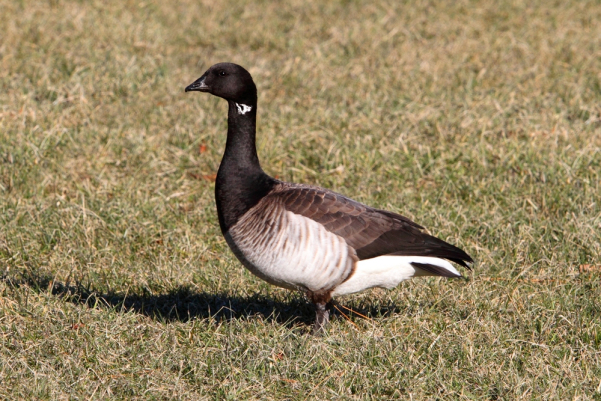
Though Canada Geese are often the bird most associated with the cold north, no other goose nests as far north as the Brant(Branta bernicla), which make their winter homes along the temperate zone sea coasts when not traveling to the high-Arctic tundra to breed.
The Brant, or Brent Goose, is one of the smaller members of the goose family with a wingspan of just under four feet long and the shortest tail of any goose. This fascinating species can be broken down into three subspecies, the dark-Bellied Brant, the Pale-Bellied Brant, and the Black Brant, which some scientists think to be completely different species of goose!
During the summer, these birds call salt bays, estuaries, and the wet coastal tundras of the high Arctic their home. When winter approaches, they take off for coastlines in more mild climates with stops in a couple of freshwater lakes along the way. During this journey they stick together in flocks and may fly at altitudes of several thousand feet when traveling from the central Canadian Arctic to the Atlantic Coast of the United States. They tend to linger later into the spring season than most other geese, as their breeding areas back in the Arctic aren’t suitable for nesting until summertime.
Not only do Brant Geese travel in flocks, they feed this way too! They eat a wide variety of plant material, especially aquatic plants during migration season and winter, which they can find by foraging along the shore or on tidal flats as a group. They love eelgrass and will favor it when it’s available, but will also eat widgeon grass, rockgrass, and green algae. When on breeding grounds, they graze on grasses, sedges, and pond weed as well as a few aquatic insects, mollusks, and worms.
Breeding pairs are usually formed during the winter and travel back north together to build a nest. Nesting sites are usually on small islands in tundra ponds or within 1 to 5 miles of the coast. This means they’re often subject to destructive storm tides that can quickly and easily wash away a well constructed nest. Brant nests are usually made of grass and other materials that will be heavily lined with down to protect the eggs inside. It only takes around 24 days for the 3-5 eggs laid to incubate, and, once they hatch, the young will leave the nest within 1-2 days. The parents will show the babies where the feeding areas are and show them how to find their own food. 40-50 days later, they’ll have the feathers they need to begin learning to fly!
| Length | 55-66 cm(1’9.7″-2’1.9″) |
| Wingspan | 1.1-1.2 m(3’7.3″-3’11.2″) |
| Weight | 850 gm-1.81 kg(1.87-3.99 lbs.) |
There are three subspecies of Brant and all of them are a little different from the others. Here’s a quick overview on how you can tell the difference:
Dark-Bellied Brant B. b. bernicla
Like their name suggests, Dark-Bellied Brants are a dark grey-brown color all over except for their head and neck, which are black. There are small white patches on both sides of the neck. These Brants breed on the Arctic coasts of Siberia and winter in western Europe, splitting their population of roughly 250,000 between southern England and the Germany-France region of Europe.
Pale-Bellied Brant B. b. hrota
These geese can easily be picked apart from their cousins thanks to their much lighter color. Pale-Bellied Brants don’t have a uniform color like dark-bellied ones, instead they have different shades of gray-brown all over their bodies with a paler color for their flanks and bellies. Just like their cousins, however, they have black heads and necks, with matching white patches on each side. Most of the 250,000 wild Pale-Bellied Brants spend their time breeding in northeastern Canada and wintering along the United States’ Atlantic coast. During this time of year, you can spot these birds anywhere from Maine to Georgia! There are two other populations that live in Europe and split their time between different areas of Scandinavia.
Black Brant B. b. nigricans
Finally, there is the Black Brant, the blackish-brown and white variety of this species. Unlike the other two kinds, the white patches on its neck connect to form an almost complete collar and match another prominent white patch on its flank. The Black Brant population is quite a bit smaller than the pale-bellied or dark-bellied population at only 125,000, but they can be found in similar places as their cousins, like Canada, Siberia, and the United States. Black Brants can also be found in east Asia, mainly Japan but also Korea and China.
Conservation Status
The Brant is listed as least concern.
